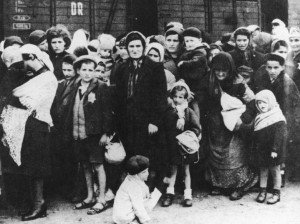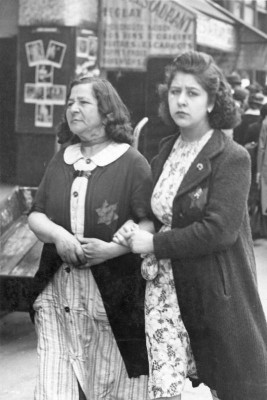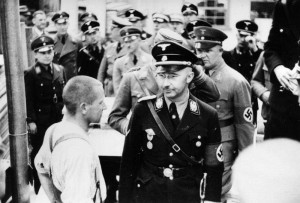In January 1933, there were over 500,000 German Jews living in Germany. But with escalating anti-Semitism throughout the 1930s, there was a wave of German-Jewish residents moving out of the country. From 1933 to 1939, approximately 300,000 Jews left Germany and immigrated to other countries, including the United States. From 1939 until the end of World War II, nearly 180,000 German Jews had been killed by the Third Reich.
Before World War II
At the start of World War II, most of the businesses owned by German Jews were experiencing declining profits or had simply failed because of financial pressures. In 1936, most German Jews were prohibited from working in professional jobs. This effectively prevented them from having any kind of influence in politics, higher education, and industry.
Many Jews were forced to sell their companies to the Nazi government in Germany. This was due to the “Aryanization” policy which began in 1937. During this time period, there were many pogroms (race riots) against the Jews. Many times, the German government encouraged these pogroms.
One of the first pogroms happened in Kristallnacht, Germany. It was called the “Night of Broken Glass,” or the Pogromnacht, and occurred in November 1938. Many Jewish residences and businesses were vandalized and ransacked by SA (Nazi) storm troopers and civilians. They used sledgehammers to smash windows and left streets covered in broken glass.
Many German Jews were beaten and killed. About 30,000 Jewish men were sent to concentration camps. Over 1,500 synagogues were vandalized and more 200 of them were set on fire. By the early part of 1939, only about 16 percent of Jewish families had some type of steady employment.
During World War II
During the first part of the war, the German government enforced new restrictions and regulations on the Jews that remained in Germany. Among the initial restrictions was a strict curfew that banned Jews from going into certain areas in several German cities. Later, when food rationing started, German Jews were given reduced rations. New regulations stipulated the times when Jews could shop and also restricted them to using only specific stores. This resulted in most Jewish families experiencing shortages of basic needs and essentials.
The German government also required that Jews turn over their property as part of the war effort. Jews were required to give many items to local authorities, such as cameras, radios, electrical appliances, bicycles, and other valuables. In September 1941, a new decree prohibited German Jews from using any type of public transportation.
During that same time period, Jews who were six years old or older were required to wear a yellow Jewish Star on the outside of their clothing. Strict residence regulations were enforced that forced Jews to live in specified areas in German cities. They were also forced to perform compulsory labor.
Deportations of German Jews
The very first deportations of German Jews began in October 1939, under the Plan of Lublin, or Nisko. This deportation plan was to create a Jewish “reservation” within the Lublin District which was a part of German-occupied Poland. Adolf Eichmann, an official of the German Reichssicherheitshauptamt (RSHA), planned the transfer of over 3,000 Jews from Moravia, Kattowitz, and from Vienna to Nisko, located next to the San River. There were many problems with these deportations and later German policy put a stop them.
Also, RSHA officials deported nearly 100,000 Jews from the District Wartheland, Danzig-West Prussia, and East Upper Silesia, during the last part of 1939 and the early part of 1940. In October 1940, Gauleiter Josef Bürckel expelled approximately 7,000 Jews from Saarpfalz and Baden to various areas of France. The French government took most of them to the Gurs internment camp located in the southwestern part of the country.
In October 1941, German government authorities began to systematically deport Jews from Germany. Under the Reich’s Citizenship Law of November 1941, all German Jews that were sent to the East automatically had their property confiscated when they crossed the Reich frontier.
Nearly 50,000 German Jews were deported to Lodz in 1941, and also to Izbica, Piaski, and Warsaw, as well as other locations during the first part of 1942. Many others were sent with Polish Jews to Treblinka, Belzec, and Chelmno (Kulmhof). Many were forced to work in labor camps. By October 1942, Germany had sent most of the remaining Jews to Theresienstadt or Auschwitz-Birkenau.
Confiscation of Jewish Property
At the beginning of 1943, after most of the mass Jewish deportations to Auschwitz or Theresienstadt had taken place, the German government passed laws that legitimized the its seizure of the remaining Jewish property and its distribution to the German population. In July 1943, German Jews were removed from receiving any kind of protection under German law. Instead, they were placed under the RSHA, also known as the Reich Security Office.
The nation’s laws at first exempted German war veterans that were Jewish along with elderly people that were 65 years old or older. Jewish individuals that had married German Aryans were also exempt. Eventually, the German government deported highly-decorated and disabled Jewish war veterans in addition to many prominent or elderly Jews from Germany and the Netherlands to a ghetto near Prague – the Theresienstadt.
The Theresienstadt was a way station for many Jews that were being deported to the East. The SS regularly moved German Jews from Theresienstadt to the Baltic States, Poland, and Belorussia. Over 30,000 people perished in Theresienstadt, mainly from mistreatment, illness, and starvation.
In May of 1943, German officials reported that the Third Reich was free of Jews. After mass deportations, there were less than 20,000 German Jews remaining in the country. Some survived because they were not married to another Jew and others were allowed to remain because they were only part Jewish. Some survived by hiding and they were often aided by non-Jewish Germans.
After World War II
Overall, the Germans along with their collaborators killed between 160,000 and 180,000 German Jews in World War II’s Holocaust. This figure also includes the majority of the Jews that had been sent out of Germany.
The German-Jewish community began to grow again after the war. Many Jews immigrated from Israel and countries from the Soviet Union. At the beginning of the 21st century, there were nearly 200,000 Jews living in Germany. After the war, Germany was the only country in Europe that experienced an increase in Jewish population.



